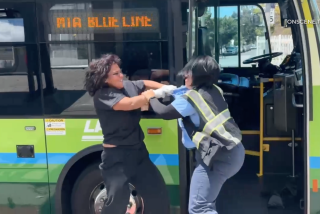Marketers Are on a Roll With Wrapped Buses
- Share via
NEW YORK — Duracell wanted to show off a new gizmo on its batteries. The Gardner Museum felt its timeless masterpieces could draw a crowd. And Avon Products wanted to dispel its stodgy image on Wall Street.
So they got on the bus. Several buses, actually.
These companies created special advertising that covered buses from bumper to bumper, from tires to roof and across most of the windows. The buses then went back on the road in places like Los Angeles, Dallas, Boston and New York.
Ad professionals call them fully-wrapped buses and they are showing up in greater numbers these days in cities and suburbs across the country. Greyhound soon plans to run wrapped buses on its inter-city routes.
“They let us take a billboard-sized display and let it roam the streets,” said Jodi Yegelwel, director of marketing for TDI Worldwide, a leading marketer of mass transit ad space. “When people see a billboard rolling down Madison Avenue or Wilshire Boulevard, it is still exciting and gets a lot of attention.”
Advertisers once had to paint a bus if they wanted to drape an ad message over the entire vehicle. That took a long time and was hard to replicate. And the windows couldn’t be covered.
But innovations in the late 1980s allowed displays to be imprinted repeatedly on vinyl. The vinyl has self-adhesive backing, can be applied to buses like wallpaper and be removed without damaging the original bus colors.
The vinyl applied to the windows is perforated so the displays look seamless and opaque from the outside while passengers inside can see out just as clearly as they would through tinted glass.
The displays can be breath-taking. They have included mouth-watering hamburgers stacked as high as a bus, colorful soft drink bottles nestled by waves of water and chunks of fruit, and airplanes framed by clouds.
Duracell’s display in 12 major markets this summer, for example, makes the bus resemble one of its copper-top batteries with the new yellow power gauge that comes on its latest models.
The Gardner Museum put a montage of artwork on one side and a scene from one of its lush courtyards on the other for its display. The museum said attendance jumped while its bus roamed metropolitan Boston.
Avon Products featured U.S. Olympian Becky Dyroen-Lancer, a synchronized swimmer and Avon representative, on its wrapped bus display with its new ad line “Just Another Avon Lady.” Its ad was carried for three months on six buses in New York in hopes of impressing key beauty industry and investment professionals that Avon is hip and contemporary.
The growing popularity of wrapped buses has been driven by transportation agencies’ need to find ways to raise money without boosting fares. They can get much more revenue by selling a fully-wrapped bus than by selling all the regular ad space on a bus.
Typical multi-month contract rates work out to $2,500 to $6,000 a month for fully-wrapped buses compared with $400 to $500 for all the regular ad space on a bus, said Craig Heard, who heads TDI rival Gateway Outdoor Advertising of Somerset, N.J.
The extra money comprises less than 4% of the estimated $215 million in total transportation ad revenue last year. But it is welcomed by public transportation agencies who have seen federal operating assistance fall 50% since 1994.
Wrapped buses generated an extra $300,000 last year for the Pace suburban bus division of the Regional Transportation Authority serving metropolitan Chicago, for example. That was 30% of total ad revenue.
“Without that money, we would have to look at either raising fares or reducing service,” Pace spokeswoman Mindy Laflamme said.
Only a limited number of buses are wrapped in ads in any given market. That keeps them unique enough to warrant premium rates.
TDI said it has wrapped more than 500 buses nationally since putting its first wrapped bus on the streets of San Francisco for the ill-fated Crystal Pepsi soft drink in 1992. P&C; Media, of Lanhorne, Pa., has put more than 200 illustrated buses on the streets and Gateway Outdoor has created about 75.
Some people worry that covering bus windows would create security concerns for police or others who may need to see inside a bus from the street. The Chicago Transit Authority prohibits ads covering its bus windows in part due to security concerns although its suburban counterpart, Pace, allows them. The Pittsburgh bus authorities encourage advertisers to design wraps that leave some windows uncovered.
But bus system officials in Boston, New York and Phoenix said there have been no security incidents. Driver windows are left uncovered in any case.
Transit officials say they deflect complaints about commercialism by explaining that the proceeds help keep buses in service. They review each display for tastefulness. Some agencies prohibit tobacco or liquor ad wraps.
“Advertisers try to make it an art form and not just an ad on a bus,” said Mike Geden, general manager of Park Transit Displays Inc., which handles Boston-area transit advertising. It has launched more than 100 wrapped buses in two years.
It can be expensive to wrap a bus in an ad. TDI’s Yegelwel said production costs run $8,000 to $12,000 per bus. She said ad space can cost as much as $7,000 a month in the biggest markets. That means the total costs for a year can approach $100,000 for one fully wrapped bus.
But they can draw crowds. People like to be photographed with the Pace bus decorated to resemble the bleachers in Chicago’s Wrigley Field baseball park. Drivers in Boston say people often wait for an illustrated bus when they know one is on the route and let the others pass by.






